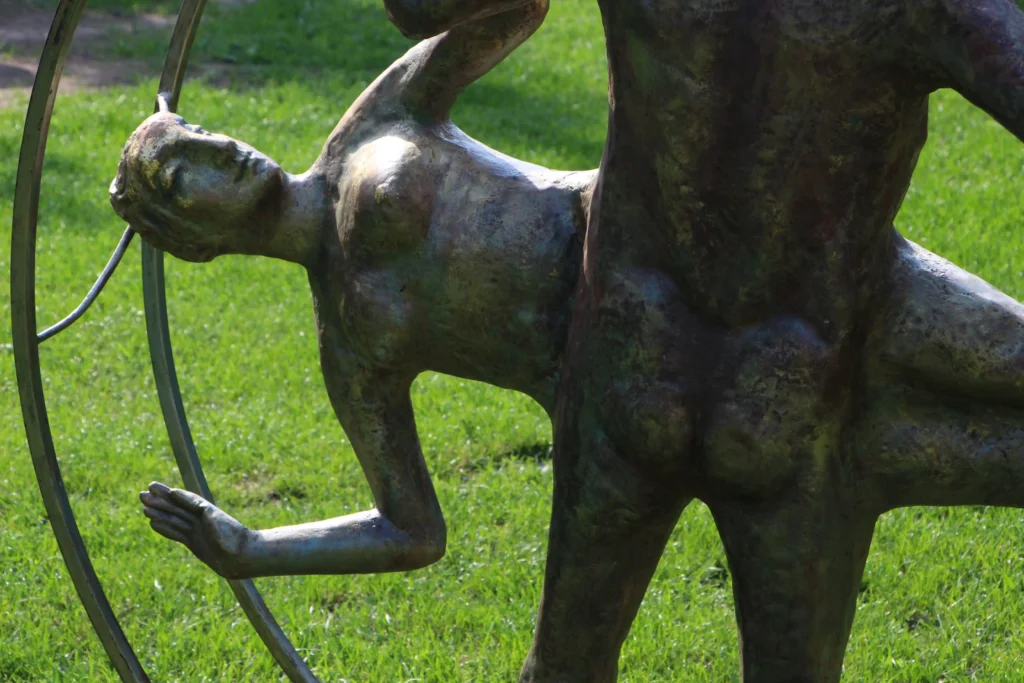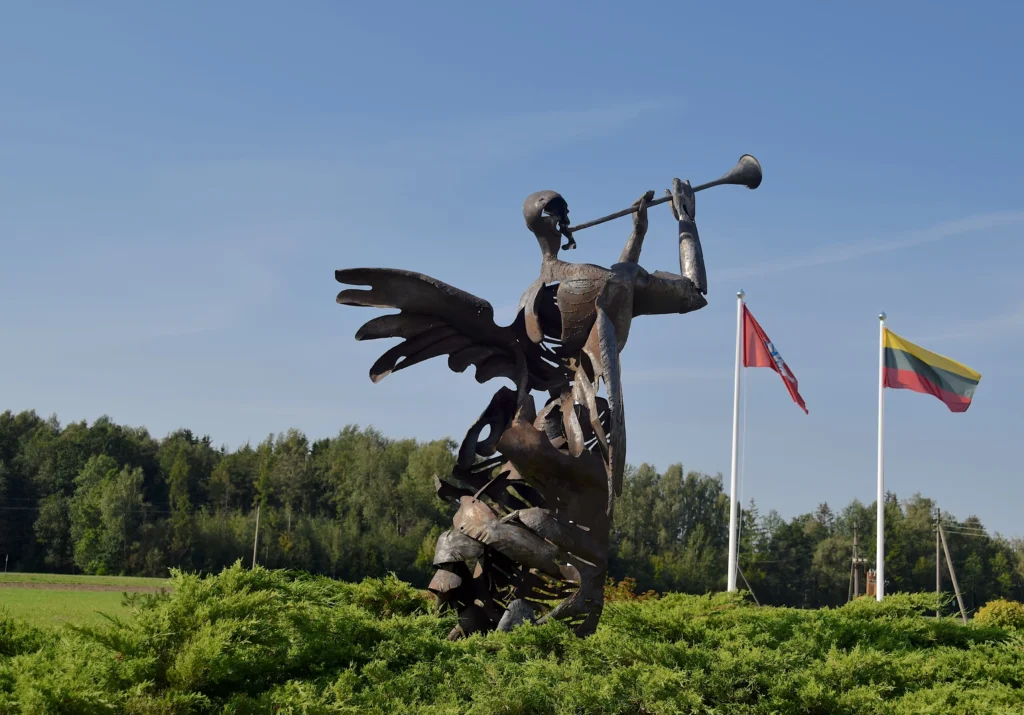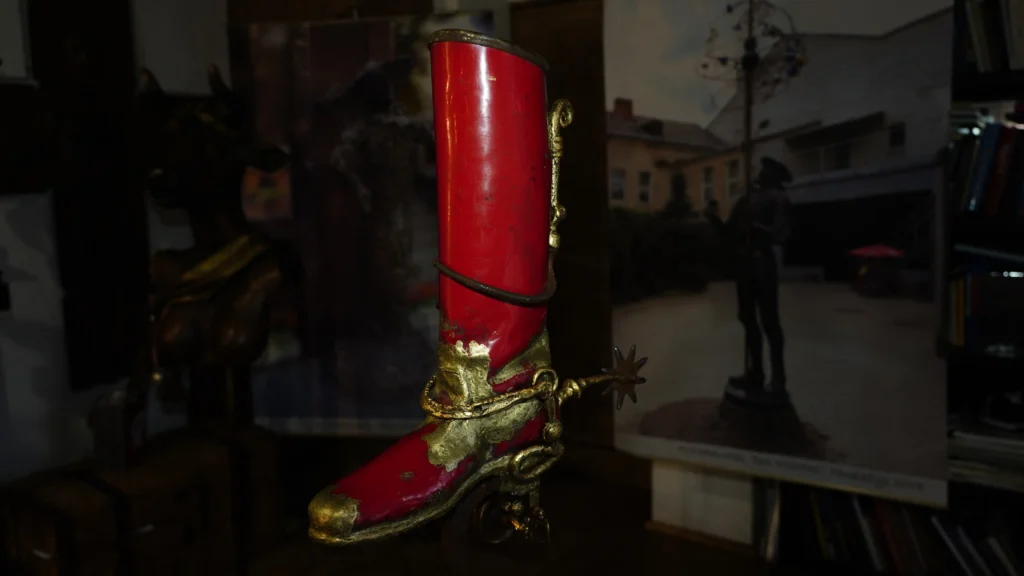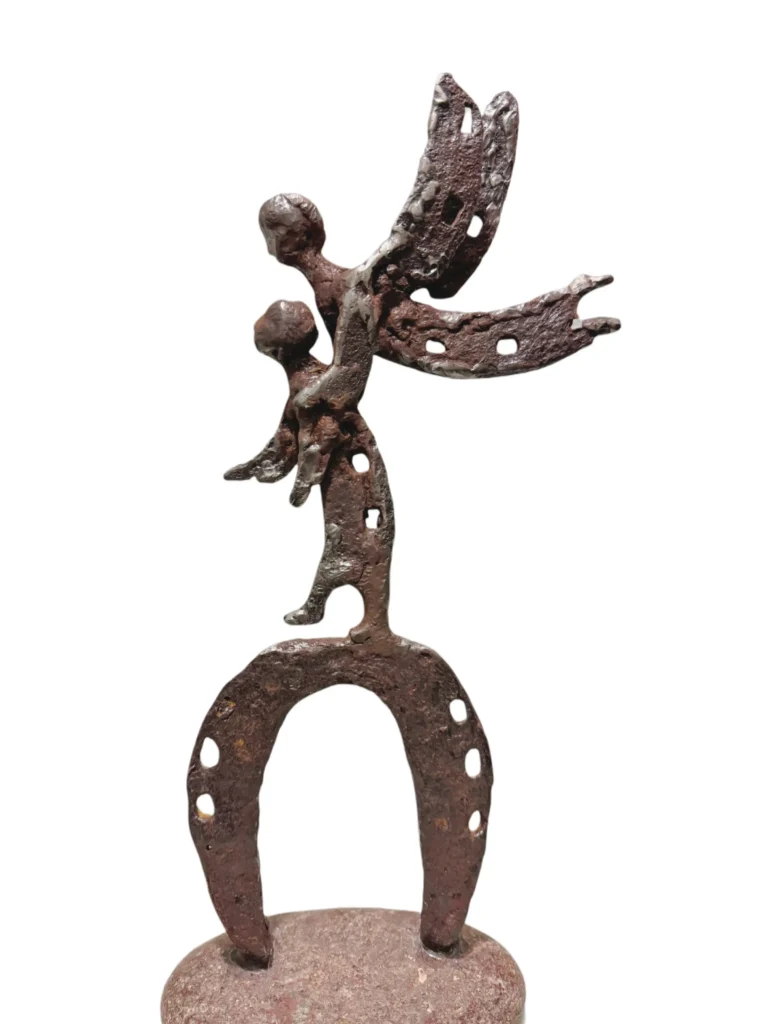A Critic’s Word 2025
Art Nagazine “Anima mundi academia”
Jurgis Dieliautas / Anima mundi academia
“HENRIKAS ORAKAUSKAS –
SCULPTURAL IRONIC HUBRIS”
This sculptural thinking strategy is based on indirect vision. Indirect sculptural vision is a derived, symbiotic vision-thinking, where detached visual sight transforms into vision. Visual thinking becomes the plastic power of insight. In another sense, such a visual vision is also a form of mental flex, an indirect connection of treatment, a breakthrough in the matter of visions. It is also a renewed expression of the exhausted material, which establishes a different circulation. It is often a plastic-mental transformation of a product. Such a transformation is a new connection. The product and the work, as spent material in the new composition of the work, show completely different plastic possibilities. Unmatched and unreconciled connection, this is an update relationship issue. The work is a unique, integral, syncretic entity. The visual formation points to such a relationship where slow plastic time comes into play. We are otherwise introduced into the sequences-circulations of that slow time.

With each of his works, Henrikas Orakauskas greets us with an infinity of plastic ingenuity that leads to parallel, invisible, sometimes ambiguous compositional and creative themes. All this is accompanied by peculiar hybrid games. Each component has become an integral part of the creative material. This sculptor’s creativity includes peculiarly stylish hybrid play. Individual components of the sculpture are a never-ending ironic polemic with a dominant attributive purpose, objective attribution of properties, the inevitable necessity of existing connections, and direct consumption of the product. Individual components, ironically removed from their immediate effectiveness, are introduced into the realm of endless paradox, discovery, and ironic doubt.
Disturbing values begin to act, renewed connections of broken connections manifest. The recycling, reproducing power, in an ironic, negating, alienating relationship, becomes a restorative, reminiscent, inclusive power. The hybrid play in the circulation of compositional forms of an individual work is always enhanced by the introduction of ironic distance. It is necessary to look at many things from a creative perspective. It is necessary to properly move away from utilitarian unequivocalness and productive initiative in order to see new, visible meanings. The piece keeps us at such a distance for a long time, with a slow rhythm. Ironic distance also creates plastic distance. The usual sculptural component, exponential formations, subject attributes lose their necessary weight, their usual gravity, and at the same time their usual production-subject fate. Forgotten in the making, left behind in the execution of the qualities of ingenuity, the possibilities of renewal easily return from the other side of the circulation. Goals are clarified, qualities are rediscovered, inevitable connections are disrupted by skeptical ambition, ironic hints. The utilitarian teleology of the product turns into an updated, self-opening logos.
“Digitalized David”

Material use liberates itself from necessary convenience, rises to the mental sphere. Endless smart hints of details emerge from this plane that have found themselves, updated features filled with other important nuances. Irony leads to the climax of the story, surprise, disturbance. Ironic surprise here becomes plastic surprise. Plastic wonder is filled with an expression full of impossible possibilities. But everywhere there remains a visual difference, an additional shift, some delayed, engrossing action. In a long and slow view, the product seems to leave the production circulation by itself, the product just stops working, it turns into an engaging creative circulation. This plastic nature of distance always increases the emergence of a complementary narrative alternative.
L. Pališkis foto
“Perpetuum Mobile”
The alternative is an untapped, deferred relationship, the efficiency of unproven qualities, a self-replenishing initiative. With an inseparable hint of laughter, lightness, skepticism. Then the properties reveal themselves differently, then the traits present a different way of being. Hesitation becomes doubt, and doubt a self-creating plastic smile. Intelligence is a self-doubting otherness, a secondary feature of the visual history of the other work. The ironic wisdom of the sculptural narrative leads to complex, broken connections that remain in the artistic possibility, aimed at renewal, transformation, and plastic opening. There is no forced matter-of-fact approach in this plastic expression. A matter-of-fact attitude, a grumpy and numb attitude, ambitions muted by fatigue, original intentions forgotten. The plastic qualities derived from a messy slumber, irritable decay, and turned into an ironic metallic narrative would leave it, qualities that have lost their purpose. The ironic rust, the angry folds turning into a whip, the mysterious cavities hiding the approaching closeness, all these are the characteristics of products and articles that are always searching for artistic discovery. Thanks to these qualities, the product and the article of imperceptible qualities go out into the field of creative qualities, another light and another light diffusion field, where the plastic wisdom works. Plastic wisdom, sculptural wisdom can be light and playful, finding in weight and pressure the qualities of ironic etachment, divine laughter, the qualities of carnival symbolism.
R. Šileikos nuotrauka

“The Trumpeting Angel”

The sculptural thinking of Henrikas Orakauskas is based on a peculiar plastic rhetoric, which is full of slow and flexible intentions, filled with echoes of silenced syncretic material. Sculptural thinking in the author’s field is an abundance of visual challenges, mental invitations, and other things. Unnoticeable, only emerging, forgotten or ignored topics that remain on the other side of direct polemics develop in authorial connections. Visual rhetoric changes the usual, rapid pace of perception. Performance here becomes tropic to slowed-down actions arranged in a plastic space. Actions are on the other side of action, the expression of action is on the other side of effect. The sculptural thinking of Henrikas Orakauskas is full of plastic intrigue, unexpected twists into confusing compounds, complex and imperceptible integral formations, slowed-down generalizations. From a skeptical beginning, there is a transition to a receptive living beginning. The receptive beginning here is the creation of a vision of connection, the search for visual resources on the other side of ordinary knowledge. This is how synthetic plastic intrigue is created and assembled. Plastic intrigue in its connection holds an unexpected possibility of mental contact, a gyrating spin. From the sacred to the attributive sphere, a specific xpression takes us, from the sphere of the product, the work of art rises to a wider sphere, the plastic connection of matter.
B. Orakauskaite photo
“The Conqueror’s Shoe”

A plow can be a knot, a tied plow can symbolize transformation. The metal knot as a plastic symbol can become an alternative visual summation. The node of the epoch, the transition to another transformation, can also signify ironic changes. Ironic changes in the expressions of plastic deliberation become the beginning of new initiatives. Action at the level of plastic consideration has a visible and discernible side. A visible power gap, an unexpected shift in an ironic composition, an outbreak – all of this transforms the usual, strictly defined initiatives. Sculptural thinking is full of visual ambiguity. The visual sphere of intelligence and creativity is a realm of complex interactions. Visual intelligence not only reveals the diversity of connection but also seeks manifestations of the power inherent in such diversity. Visual-plastic material also demonstrates such manifestations. Sculpture is a philosophy that transforms knowledge. The game of expression is intertwined with the world’s play, obstacles, and distractions. The expression of intelligence settles into sculptural color. Visual sediment meets mental sediment. When a smart visual plan becomes a polemical plan, when plastic expression turns into directions of flight.
A. Kuzmickas photo
“Flying Lesson”
There are many reciprocal, double, twin, ambivalent shifts into complex spheres. One plastic sphere comments, analyzes, and provokes other spheres. We can describe such sculptural beginnings, such plastic components, as the distance of hybrid sculpture. The distance of hybrid sculpture is a mutual displacement from the product and the work, from the object and from thought in different directions. It resembles a ritual, circling the sculpture from various sides. Distance here is not the act of repulsion itself but the act of distance as an effect. The effect is the action of the hybrid joint’s taming effort. Plastic distance as an action of liveliness, artistic matter deviates into other actions. Such actions are sometimes full of plastic paradoxes. The author turns these plastic paradoxes into ironic symbolism. A plowing angel, a metal angel is a plowman pulling a metal plow behind him. The mentioned mixture of eras, curiosities of fate, paradoxes of exchange and transformation – all of this defines a new, hybrid connection. In the creation of symbols, the author transcends the symptomatic, selective spheres and introduces them to different conditions of physical-mental action.
G. Milius photo

“The Wandering Rye Field”

The sculptural expression of Henrikas Orakauskas is an open polemic with the changes of the past and the world, reversible and irreversible changes in different plastic planes. It is precisely the significant plastic changes that create new tensions and endless hesitations. The author turns this into a peculiarity of the duality of presentation and display. For the unstable flexibility of the world, the artificial elasticity of the world, the author presents an ironic elasticity, an improbable flexibility at the levels of alternative interactions. Unstable, offering new flexibility, new division, the world is full of ambiguities. The approach to ambiguities, to differences, requires an artistic initiative, an artistic response. The sculptor views these ambiguities as a creator-discoverer, a seekervisionary. Two different planes, two separated meanings, two non-connecting separations can be brought together in a certain way, creating the possibility of such plasticity. All of this flows into compositional movements, into the circulation of sculptural components.
Duality is a polemic in the interactions of transparency, inside and outside, naturalness and artificiality. The invasive nature of the world turns everything into a provocative illumination-installation. The sculpture as an installation reveals the confusion of the inner, transparent side of the sculpture. The plastic exterior ironically ignores the inner status of the sculpture. Mixed plastic matter is a confusion of rapid changes, aesthetic techno sphere.
Simultaneously, it is an extended polemic of part-whole, formation-combination. In the plastic sense, the confusion itself is the confusion of the visual-plastic approach. The sculpture installation is an ironic, heuristic polemic with endless innovationinstallation, with artificial integration. At the same time, it is a polemic against the oblivion of the holistic-plastic world.
“Human Geometry”
Plastic abstraction is used in polemic work. The plastic abstraction in the author’s sculpture, woven into the abundance of existing and only implied narratives, offers a different understanding of flexibility. Lability and flexibility of solid forms, mobility of forms, compositional intelligence as a transition to other spheres – all of this plastic abstraction does not lose its existing or only predictable grace and irony. Flexible and adaptable intelligence emerges from each such connection. When processing, overcoming the mandatory setups leads to unique visual generalizations. The connection remains a connection of the impossible. Paraphrases of articles and products explore the possibilities of an impossible connection, an impossible transition, the emergence of mental matter. Plastic abstraction is specifically used for this. Plastic abstraction finds its support in duality. It takes on many forms, shows its other side. In a situational sense, such secondaryness provides its own duality, an alternative acceptance of different, sophisticated situations. In the exchange of movement metaphors, the shoe becomes a symbol of new mobility, new plastic mobilization. The extended medium of the shoe, the intermediate function of the plastic metaphor of the shoe, raises the question of the mediality of things. The shoe can travel on its own wheels with its epic, mental,mobilizing power. By overcoming attributive barriers, the shoe can move into spheres that are not necessary for the shoe as an object and are not characteristic of it.
R. Šileikos nuotrauka
